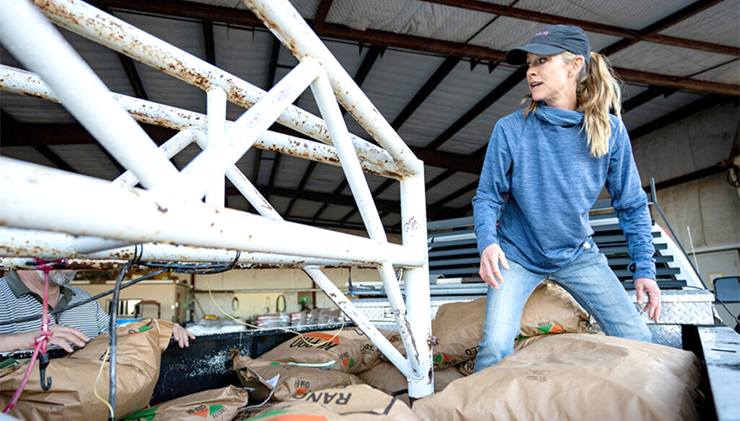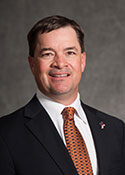
Hanna Conner types a quick message and swipes her cell phone to take a call; it’s a donated piece of equipment headed to the wrong location. Before she can complete the call, there’s another one – a semi-load of hay is coming in – and it’s going directly to either a ranch or the animal supply point.
Conner is the Texas A&M AgriLife Extension Service agriculture and natural resources agent for Hutchinson County. She oversees the Animal Supply Point, which was established after the Smokehouse Creek fire – the largest wildfire ever in Texas – swept through the region.
Her phone has been going off nonstop since that time, as she does what AgriLife Extension is known for – offering a helping hand and working alongside her community members to teach best practices for this wildfire disaster response.
Conner’s co-worker Megan Eikner, AgriLife Extension agriculture and natural resources agent in Potter County who has been helping at the animal supply point, explained that as an agriculture and natural resources county agent, she is there to ultimately help producers “take care of their livestock and their livelihoods.”
The Animal Supply Points were established on Feb. 28 in three locations, serving the east, north and west locations hit hardest by the multiple fires that ravaged the pastureland in six counties. Almost immediately, the donations began rolling in.
“AgriLife Extension is uniquely positioned because we serve all communities of this state, with county offices serving all 254 counties. Our local agents are there; they are a part of the community, so when a disaster like these wildfires happens, we are already embedded and a part of those communities,” said Rick Avery, Ph.D., AgriLife Extension director, Bryan-College Station.
“Most importantly, as the communities recover from this incident, we are still going to be there providing services and helping communities heal, both agriculturally and comprehensively as a community,” Avery said. “That’s what makes us different from all other state agencies. Not only are we relied upon as a legitimate, timely source of information, but we are also a part of the community, and that is how we make a difference in the lives of Texans.”
The supply points are rapidly filling with feed, hay, fencing materials and other animal-related supplies. When asked why the AgriLife Extension sites were chosen as the destination of donations and supplies traveling from across the country, Conner and Eikner said, almost simultaneously, “We work for the Texas A&M System, a trusted place,” and “We are trusted to provide that oversight.”
Sean Semko, who has been on the job for two months as an AgriLife Extension Disaster Assessment and Response, DAR, agent in San Angelo, said some of these ranchers have been building their herds for five generations and others for five months.
However, they all need subject matter experts who can advise them on the next steps to take during the disaster. He explained how they need someone to help them find a safe place for their animals in addition to finding feed to help sustain the livestock until they can get back on their feet.
Semko, like other DAR agents from across the state, was deployed to the Texas Panhandle to help coordinate and organize the supply point, load and unload hay and supplies, and manage inventory in support of the local county agent.
Richie Griffin, DAR area chief for the East Region, said the network is what makes AgriLife Extension great – no individual has to be an expert in everything.
“If I need an economist or a beef cattle nutritionist, we have that network of experts, and they can help us better understand the needs and wants of the people we are here to serve,” Griffin said.
The direct contact each county agent can provide to those affected in their area is unique, and their connections with local and regional businesses allow them to respond quickly. And not just within their individual counties but as a team.
Marcus Preuninger, AgriLife Extension agriculture and natural resources agent for Gray County, is a part of that team. Being fairly new to his county, he relied on his mentors to help him learn how best to serve his community and meet their needs.
Gray County was affected by both the Smokehouse Creek fire on the north side and the Grape Creek fire to the south. He said because many ranchers are still assessing their damages and needs, they cannot always come to the supply points, so they have been shipping supplies straight to the ranches.
“We all have communities of people who want to help, and we can mobilize them quickly,” Eikner said.
Conner, who is going through her first disaster as an agent, said the teamwork and camaraderie between the neighboring county agents made this disaster response possible. Working as a network, they can combine resources to address needs across the affected areas.
“People know who we are, and they trust us to give out their donations to those in need,” she said. “We have people who can find the people who need feed and hay, even if they are not able to come to our supply point, or people who can search for what they need if it is not here.”
Agents not only have duties related to their jobs when it comes to wildfire disaster response, but they also volunteer wherever they are needed because they are members of the communities.
For Conner, it was one of those connections that made her walk away from her phone after spending 15 hours a day for nine days in a row at the supply point. On March 5, Fritch Fire Chief Zeb Smith died in the line of duty.
Tears flowed as she relayed how Smith was more than just a community member – he was a friend, even serving as the president of her livestock show board. He was someone “I could call for anything I needed.”
Being relatively new to her position, she worried when the disaster struck that she didn’t know the ranchers well enough to help those in need, so she called Smith for advice. Smith worked on the ranches, so he knew the needs. On that particular day, after the fire had passed, a rancher needed people on horseback, so she reached out and got some Clarendon College students to work on the ranch.
“He was always there for me.” So, that one afternoon, she walked away and drove through the burned-out country to take time for herself but was right back at it the next day.
Even Eikner, who worked for seven years in Canadian, found herself back in her hometown volunteering over the weekend.
“Something in my soul told me to go, and I walked smack into my long-time friend who lost 25 head of her herd,” she said. “After hugging and crying, we got down to business.”
Eikner immediately went to work determining the needs of the ranch, finding those needs at the Animal Supply Point, and arranging for them to be delivered to the ranch amid the blowing dirt and smoke rising from the burned pastures. She also connected with the Texas A&M Veterinary Emergency Team and got them out there.
“It was the perfect Texas A&M System response. Their whole life was upended, and we could be there to help. I’ll never forget it because I know God put me in the right place at the right time,” Eikner said.
Griffin said, without fail, everyone has always been grateful for the AgriLife Extension supply points.
“The genuine thankfulness, the hugs, the chaplain coming by each morning to pray with us, the tightknit communities that are all so appreciative of everything we are trying to do here – those are the memories I will keep forever,” he said.
He explained how the AgriLife Extension office and the county agents are staples in those communities, so they already knew where they could get help, whether in the form of supplies or education.
“The communities know we are here for the long-term recovery process,” Griffin said. “Right now, some producers still have fire on their places. But they will come in eventually for help recovering.”
Preuninger agreed.
“We are here for them. They trust us with their education, and they trust us with their kids, so when it comes to a disaster, they trust us to be here for them through that.”






Reader Comments